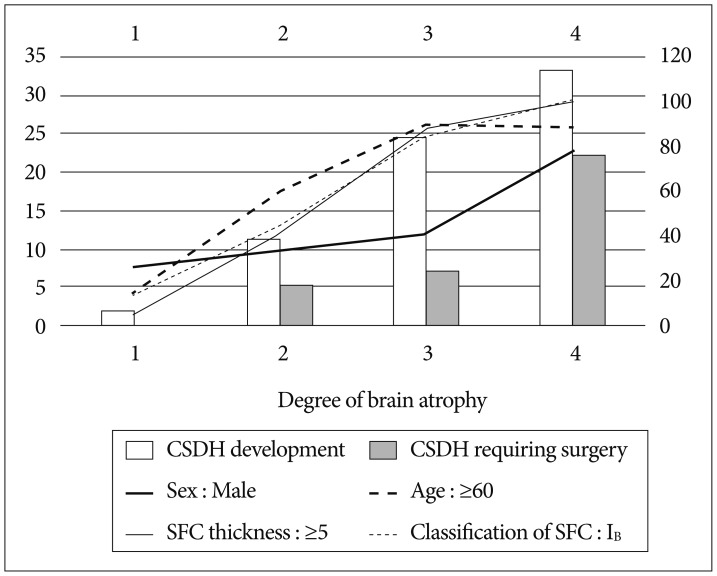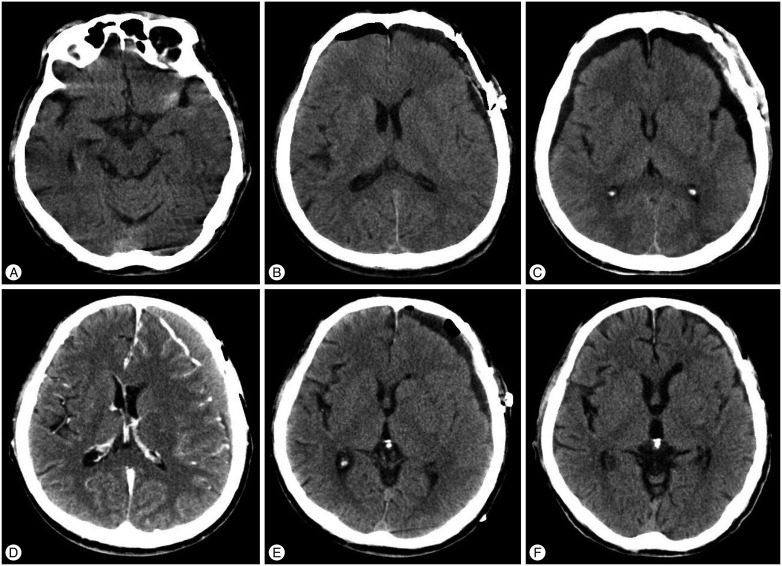J Korean Neurosurg Soc.
2016 Sep;59(5):458-465. 10.3340/jkns.2016.59.5.458.
Predicting Factors of Chronic Subdural Hematoma Following Surgical Clipping in Unruptured and Ruptured Intracranial Aneurysm
- Affiliations
-
- 1Department of Neurosurgery, Dongsan Medical Center, Keimyung University School of Medicine, Daegu, Korea. nslcy@dsmc.or.kr
- KMID: 2351713
- DOI: http://doi.org/10.3340/jkns.2016.59.5.458
Abstract
OBJECTIVE
The aim of this study is to analyze the differences in the incidence, predicting factors, and clinical course of chronic subdural hematoma (CSDH) following surgical clipping between unruptured (UIA) and ruptured intracranial aneurysm (RIA).
METHODS
We conducted a retrospective analysis of 752 patients (UIA : 368 and RIA : 384) who underwent surgical clipping during 8 years. The incidence and predicting factors of CSDH development in the UIA and RIA were compared according to medical records and radiological data.
RESULTS
The incidence of postoperative CSDH was higher in the UIA (10.9%) than in the RIA (3.1%) (p=0.000). In multivariate analysis, a high Hounsfield (HF) unit (blood clots) for subdural fluid collection (SFC), persistence of SFC ≥5 mm and male sex in the UIA and A high HF unit for SFC and SFC ≥5 mm without progression to hydrocephalus in the RIA were identified as the independent predicting factors for CSDH development (p<0.05).
CONCLUSION
There were differences in the incidence and predicting factors for CSDH following surgical clipping between UIA and RIA. Blood clots in the subdural space and persistence of SFC ≥5 mm were predicting factors in both UIA and RIA. However, progression to hydrocephalus may have in part contributed to low CSDH development in the RIA. We suggest that cleaning of blood clots in the subdural space and efforts to minimize SFC ≥5 mm at the end of surgery is helpful to prevent CSDH following aneurysmal clipping.
MeSH Terms
Figure
Cited by 1 articles
-
Arachnoid Plasty to Prevent and Reduce Chronic Subdural Hematoma after Clipping Surgery for Unruptured Intracranial Aneurysm : A Meta-Analysis
Kyoung Min Jang, Hyun Ho Choi, Taek Kyun Nam, Yong Sook Park, Jeong Taik Kwon
J Korean Neurosurg Soc. 2020;63(4):455-462. doi: 10.3340/jkns.2020.0036.
Reference
-
1. Alotaibi NM, Witiw CD, Germans MR, Macdonald RL. Spontaneous subdural fluid collection following aneurysmal subarachnoid hemorrhage : subdural hygroma or external hydrocephalus. Neurocrit Care. 2014; 21:312–315. PMID: 25030709.
Article2. Chen JC, Levy ML. Causes, epidemiology, and risk factors of chronic subdural hematoma. Neurosurg Clin N Am. 2000; 11:399–406. PMID: 10918008.
Article3. Eguchi S, Aihara Y, Hori T, Okada Y. Postoperative extra-axial cerebrospinal fluid collection--its pathophysiology and clinical management. Pediatr Neurosurg. 2011; 47:125–132. PMID: 21893956.
Article4. Feng JF, Jiang JY, Bao YH, Liang YM, Pan YH. Traumatic subdural effusion evolves into chronic subdural hematoma : two stages of the same inflammatory reaction? Med Hypotheses. 2008; 70:1147–1149. PMID: 18248915.
Article5. Gjerris F, Sørensen SC. Colloid osmotic and hydrostatic pressures in chronic subdural haematomas. Acta Neurochir (Wien). 1980; 54:53–60. PMID: 7435296.
Article6. Huh PW, Yoo DS, Cho KS, Park CK, Kang SG, Park YS, et al. Diagnostic method for differentiating external hydrocephalus from simple subdural hygroma. J Neurosurg. 2006; 105:65–70. PMID: 16874890.
Article7. Inamasu J, Watabe T, Ganaha T, Yamada Y, Nakae S, Ohmi T, et al. Clinical characteristics and risk factors of chronic subdural haematoma associated with clipping of unruptured cerebral aneurysms. J Clin Neurosci. 2013; 20:1095–1098. PMID: 23669172.
Article8. Kanat A, Kayaci S, Yazar U, Kazdal H, Terzi Y. Chronic subdural hematoma in adults : why does it occur more often in males than females? Influence of patient’s sexual gender on occurrence. J Neurosurg Sci. 2010; 54:99–103. PMID: 21423076.9. Kristof RA, Grimm JM, Stoffel-Wagner B. Cerebrospinal fluid leakage into the subdural space : possible influence on the pathogenesis and recurrence frequency of chronic subdural hematoma and subdural hygroma. J Neurosurg. 2008; 108:275–280. PMID: 18240922.
Article10. Lee WJ, Jo KI, Yeon JY, Hong SC, Kim JS. Incidence and risk factors of chronic subdural hematoma after surgical clipping for unruptured anterior circulation aneurysms. J Korean Neurosurg Soc. 2015; 57:271–275. PMID: 25932294.
Article11. Liu Y, Gong J, Li F, Wang H, Zhu S, Wu C. Traumatic subdural hydroma : clinical characteristics and classification. Injury. 2009; 40:968–972. PMID: 19540485.
Article12. Mino Y, Hirashima Y, Hamada H, Masuoka T, Yamatani K, Takeda S, et al. Effect of arachnoid plasty using fibrin glue membrane after clipping of ruptured aneurysm on the occurrence of complications and outcome in the elderly patients. Acta Neurochir (Wien). 2006; 148:627–631. discussion 631. PMID: 16763872.
Article13. Mori K, Maeda M. Risk factors for the occurrence of chronic subdural haematomas after neurosurgical procedures. Acta Neurochir (Wien). 2003; 145:533–539. discussion 539-540. PMID: 12910395.
Article14. Ohno T, Iihara K, Takahashi JC, Nakajima N, Satow T, Hishikawa T, et al. Incidence and risk factors of chronic subdural hematoma after aneurysmal clipping. World Neurosurg. 2013; 80:534–537. PMID: 23072878.
Article15. Park J, Cho JH, Goh DH, Kang DH, Shin IH, Hamm IS. Postoperative subdural hygroma and chronic subdural hematoma after unruptured aneurysm surgery : age, sex, and aneurysm location as independent risk factors. J Neurosurg. 2016; 124:310–317. PMID: 26275003.
Article16. Quintana LM. Chronic subdural hematoma after neurosurgical procedures. World Neurosurg. 2013; 80:482–483. PMID: 23159423.
Article17. Tanaka Y, Ohno K. Chronic subdural hematoma - an up-to-date concept. J Med Dent Sci. 2013; 60:55–61. PMID: 23918031.18. Xu J, Kobayashi S, Yamaguchi S, Iijima K, Okada K, Yamashita K. Gender effects on age-related changes in brain structure. AJNR Am J Neuroradiol. 2000; 21:112–118. PMID: 10669234.19. Yagi K, Irie S, Inagaki T, Ishii Y, Saito O, Lee T, et al. Intraoperative arachnoid plasty has possibility to prevent chronic subdural hematoma after surgery for unruptured cerebral aneurysms. Neurol Med Chir (Tokyo). 2015; 55:493–497. PMID: 26041629.
Article20. Yamashima T. The inner membrane of chronic subdural hematomas : pathology and pathophysiology. Neurosurg Clin N Am. 2000; 11:413–424. PMID: 10918010.21. Yoshimoto T, Houkin K, Ishikawa T, Abe H. Arachnoid membrane closure. Prevention of postoperative cerebrospinal fluid leakage. Surg Neurol. 1999; 52:68–71. discussion 71-72. PMID: 10390177.
- Full Text Links
- Actions
-
Cited
- CITED
-
- Close
- Share
- Similar articles
-
- Subdural Hematoma Due to Ruptured Intracerebral Aneurysm
- Two Cases of Posterior Communicating Artery Aneurysm Complicated by Massive Subdural Hematoma
- Current Update on the Randomized Controlled Trials of Intracranial Aneurysms
- Surgical Intervention for Cases of Ruptured Intracranial Aneurysms Accompanying Large Intracranial Hematomas
- Pure Acute Subdural Hematoma without Subarachnoid Hemorrhage Secondary to Posterior Communicating Artery Aneurysm Rupture: A Case Report




